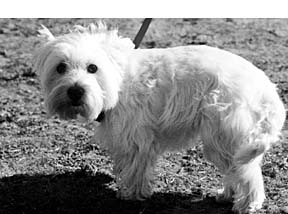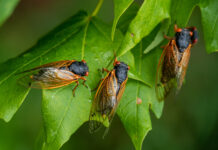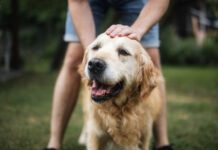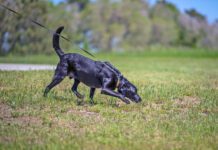Dark clouds boil on the horizon, and a slow rumble of distant thunder delivers a slight vibration in the window panes. Jake, a large long-haired Chow-mix, is already nervous. He paces the living room, wild-eyed and panting, his body trembling with anticipation of the first dreaded clap of thunder. When it strikes, he tries to hide under the coffee table, and just like last time, he is too big to fit. The very same vase that was glued together after Fourth of July is reduced to a heap of jagged shards.
Jake’s problem is not uncommon. Millions of dogs have panic attacks, some quite severe – and each one is unique to the individual and the circumstances that trigger his or her fear.
Take the case of Mercury, a rescued Greyhound in San Diego. Terror comes whenever his people invite company over. He whines and barks, interrupting conversation, and sometimes getting so excited that he throws up his dinner, ruining the party for everyone.
Mitsy, a miniature poodle who lives in an upstairs apartment on Manhattan’s East side, has panic attacks, too. Although she is a show dog who enjoys meeting people, she is terrified of the groomer. And although each grooming ends with a tail-wagging romp around the salon with a gourmet cookie that she must dream of between visits, her anticipation of buzzing trimmers and squirting hoses is too much. With each visit she hides under the car seat, then leaves a trail of fear-forced urine between the car and the grooming table.
Although chronic behavior problems may be due to underlying nutritional, emotional, or physical health issues, most sudden-onset cases are caused by the fear or confusion of a stimulating event. Finding a lasting cure for your dog’s phobia can be difficult, and the stimuli that triggers your companion’s panic attacks might be impossible to avoid.
However, the intensity of her attacks may be safely minimized with the use of calmative herbs – those that promote relaxation and help take the nervous edge off exciting events.
One of the greatest advantages of using calmative herbs is the gentle manner by which they can promote relaxation without affecting mental capacity or physical performance. The medicinal effects of the herbs I mention in this article are very subtle; they help take the edge off nervous anxiety, but do not induce a state of sluggishness or impaired consciousness.
However, it is important to note that each and every dog is unique in what their bodies and behavioral traits require. Some herbs work well in some dogs but not others. Likewise, an herb that is appropriate for calming down dog A may be a poor choice for dog B. For example, valerian will sometimes make a hot, red-tongued, perpetually panting dog grumpy. For such a dog, passionflower, lemon balm, or skullcap may be better.
It also makes little sense to increase the dose of an herbal calming remedy that does not appear to be working well. Instead of running the unnecessary risk of nausea (the most common side effect of overdose), it is better to opt for a different herb – one that is better suited to the individual and circumstances.
It is also important to remember that calmative herbs should not be used within 24 hours of anesthesia or in combination with sedative or antidepressant drugs. Although safe and forgiving (especially when compared to most pharmaceutical drugs), most calmative herbs work their magic by acting upon the central nervous system. Therefore, they may add to the effects of drugs that work by similar means.
Following is a descriptive list of four calmative herbs that I frequently recommend for dogs. You will see that each one possesses one or more qualities that make it unique and especially useful in specific circumstances.
Any or all of these herbs can be combined to create a multi-purpose formula that will appeal to a broad variety of individuals and needs. For instance, I frequently use and recommend a liquid extract formula that combines valerian, skullcap, oat flower, and passionflower. This formula works well as a general-purpose herbal calmative in most dogs – even the aggressive, hot-blooded types for which valerian, if used alone, is not indicated.
Valerian (Valeriana spp.)
Valerian is, without doubt, the most widely recognized herbal sedative in existence. As a sedative, valerian works safely and gently to help calm the nerves and achieve physical relaxation. It does not induce an altered state like one would expect from a prescription sedative or from consumption of alcohol.
Herbalists use valerian for insomnia, nervous anxiety, and to help the body relax in the presence of physical pain. It is very useful for calming animals during thunderstorms, trips to the vet or groomer, or to help your companion rest after surgery.
When employed as a sedative, valerian is most effective fed in small doses, given several times daily over a period of several days. This is especially true when it is used in anticipation of a high-anxiety event, such as a planned interstate trip or a show. In these circumstances, dogs can be fed five drops of a low-alcohol valerian tincture, three or four times daily, starting three days prior to an anticipated fearful event.
In the digestive tract, valerian serves as an antispasmodic, making it useful in situations where nervousness is compounded by a spastic colon or an upset stomach.
Keep in mind, however, that valerian may have a reverse, stimulating effect in a small percentage of animals. If this happens, simply stop use and opt for another calmative herb. It also considered a “warming” herb, meaning that it may not be appropriate for dogs with a hot, aggressive disposition unless it is combined with other calmative herbs.
Skullcap (Scutellaria laterifolia)
For centuries, herbalists have recognized skullcap as one of the most effective nerve-calming herbs available. It is commonly used for acute or chronic cases of nervous tension or anxiety, and to help relieve pain from nerve-related injury or disease.
Skullcap is useful for general nervousness and excitability in dogs and cats, especially when the animal’s condition is characterized by jumpiness, trembling, or oversensitivity of the peripheral nerves. It is also useful for relieving nervous tension related to pain or a traumatic experience.
Skullcap acts to moderate an animal’s responsiveness to physical or non-physical stimuli, and helps alleviate general restlessness and nervous twitching. This makes it very useful in high-strung felines who are recovering from a frightful experience, but who need all of their survival mechanisms intact during their daily outdoor adventures.
Oat (flowering tops of Avena sativa)
The flowering tops of the oat plant are an excellent nervous system tonic for aging or debilitated animals. This herb contains considerable amounts of protein (gluten), vitamins, and minerals (especially calcium, manganese, iron, copper, and zinc) that are essential to the maintenance of health.
It also contains various alkaloid, sterol, and flavonoid constituents that act together to safely optimize nervous system functions while stabilizing the highs and lows between nervousness and mental lethargy.
For instance, when fed in moderation to animals with chronic nervousness, oat tends to have a calming effect, but when fed to debilitated animals, it tends to stimulate the nervous system. Oat flower tea or tincture is an excellent choice for animals recovering from exhaustion, or for those suffering from depression disorders.
It is known to improve nerve transmission, and can be useful in problems such as epilepsy, tremors, paralysis, and twitching. It is a very good tonic for nourishing the body and strengthening nerve function following periods of sedation or anesthesia.
Passionflower (Passiflora incarnata)
Passionflower is my first choice for fear-biters and other dogs who take on aggressive behavior during stressful situations. It is indicated where valerian is not – for hot-tempered animals or rare instances where valerian has a reverse, stimulant effect.
Passionflower is an excellent choice for taking a bit of the nervous edge off of jealous types who don’t want other dogs to visit their homes or who insist on being the grump of the toy party at doggie daycare.
How to feed these herbs
A number of calmative herb products manufactured specifically for use in dogs and other companion animals are available. Many come in the form of pills and capsules, while others are in liquid extracts. Some products also contain melatonin or other nonherb, calm-inducing supplements. Virtually all natural calming products are most effective when fed prior to actual need. By feeding the remedy to your companion 20 minutes to an hour before he will be exposed to his stress triggers, you allow the active constituents to be fully absorbed and working when chaos ensues.
Also With This Article
Click here to view “Holistic Help For Everything”






